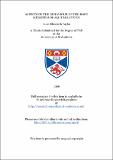Aspects of the behaviour of the root meristem of allium sativum
Abstract
The root meristem of Allium sativum has been described from longitudinal and transverse sections of the root apex. No evidence for the presence of a quiescent centre can be gained from a Norper-kappe analysis of cell patterns. The presence at the pole of the stake of a quiescent centre comprising 30-50 cells has been demonstrated by autoradiographs of roots fed with tritiated thymidine. Rates of mitosis in different regions of the root meristem have been measured by three independent methods. A) metaphase accumulation b) continuous labelling c) pulse labelling The results of the three methods are consistent and show that the rate of mitosis in the quiescent centre is of the order of ten times that in other parts of the meristem. The duration of the different phases of the mitotic cycle have been measured for various regions of the meristem by a pulse labelling for various regions of the meristem by a pulse labelling technique. It has been found that the time spent in mitosis and the later stages of interphase is approximately similar in all regions of the meristem. The extent of the mitotic cycle in quiescent centre cells is due to the length of time spent in G1 the period of interphase prior to DNA synthesis. Quiescent centre cells contain the 2G amount of DNA during approximately 90% of their cell cycle. It has been found that during recovery from colohicine treatment the mitotic index in the quiescent centre rises while it falls in other regions of the meristem. The cells forming the primordium from which the root regenerates after colochicine treatment are derivatives of quiescent centre cells. Using the number of cells carrying micronuclei as an estimate of radiation damage the radiosensitivity of different regions of the root meristem of Allium Sativium have been investigated after various doses of X-rays. It has been found that the cap initials are the most radiosenstive and quiescent centre cells by far the least sensitive. The duration of G1 is shorter in the cap initials than elsewhere in the meristem while it is longest in the quiescent centre. Cells from the two regions of the stele are approximately equally sensitive, the average values of G1 in these two regions are the same. Rates of mitosis in the different regions of the meristem have been measured by metaphase accumulation at various times after irradiation with 250 rads of X-rays. It the quiescent centre three or four days after irradiation the rate of mitosis is greater than in the other regions of the root being ten times that found in the quiescent centre of unirradiated control roots. Average rates of micosis in the rest of the meristem are considerably reduced.
Type
Thesis, PhD Doctor of Philosophy
Collections
Items in the St Andrews Research Repository are protected by copyright, with all rights reserved, unless otherwise indicated.

